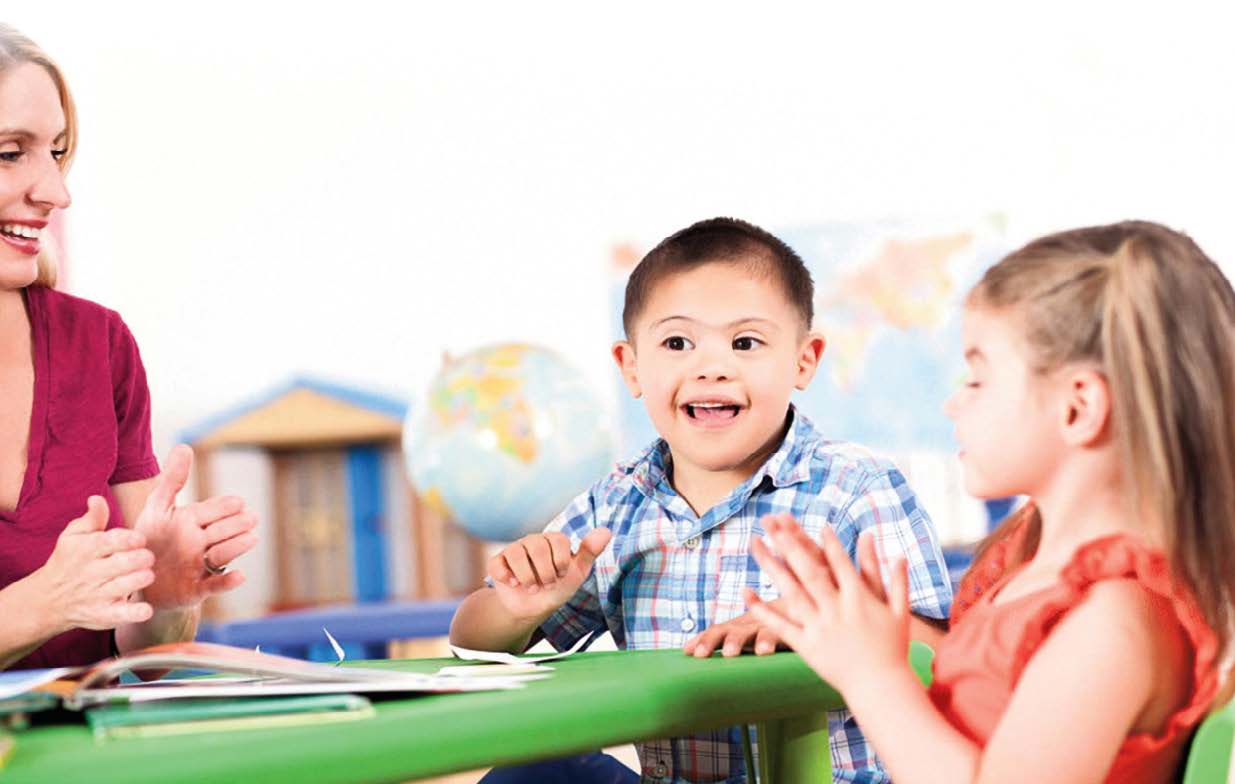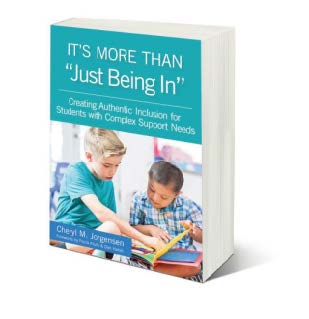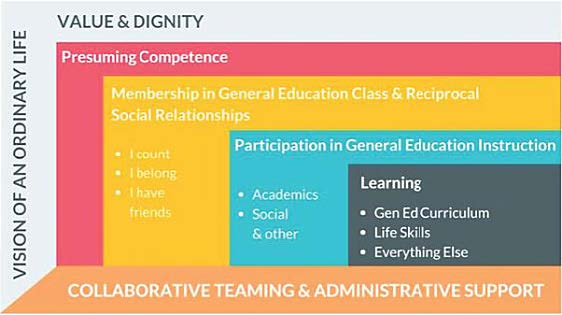It's More Than 'Just Being In' Creating Authentic Inclusion For Students With Complex Support Needs"
BY LAUREN AGORATUS, M.A.
EdWeb recently held a webinar, "Inclusion Is More Than 'Just Being In'" presented by Cheryl M. Jorgensen, Ph.D., who just wrote a book on this topic.
LET'S START AT THE BEGINNING…
Chapter 1 begins with the basic tenets of inclusion. Marsha Forest coined the term "inclusion" at a 1987 parent conference. The definition of inclusion means that all students "are presumed competent, are welcomed as valued members of all general education classes and extra-curricular activities in their local schools, fully participate and learn alongside their same age peers in general education instruction based on the general education curriculum, and experience reciprocal social relations.1" And they are truly welcomed, not just "tolerated."
When the Individuals with Disabilities Education Act (IDEA) was reauthorized, Congress indicated its support of the principle of inclusion, stating, "Disability is a natural part of the human experience and in no way diminishes the right of individuals to participate in, or contribute to society. Improving educational results for children with disabilities is an essential element of our national policy of ensuring equality of opportunity, full participation, independent living, and economic self-sufficiency for individuals with disabilities.2" IDEA promoted the concept of Least Restrictive Environment (LRE), and the IDEA regulations read, "To the maximum extent appropriate, children with disabilities, including children in public or private institutions or other care facilities, are educated with children who are nondisabled; and 2 Special classes, separate schooling, or other removal of children with disabilities from the regular educational environment occurs only if the nature or severity of the disability is such that education in regular classes with the use of supplementary aids and services cannot be achieved satisfactorily. This can be summed up as indicating that inclusion is more than just physical presence – it's about participation. The chapter concludes with research indicating the benefits of inclusion for students both with and without disabilities.
CHAPTER 2
Chapter 2 expands on the notion of presence vs. participation. There is a range from being present/having presence, to participating, to connecting/contributing. There is a discussion of person-centered planning using processes such as MAPs (Making Action Plans). This involves a strengths-based approach for students. The chapter includes examples of vision statements. There should be a vision statement on the IEP which can be updated as the student progresses each year. One of the most important considerations using MAPs is "What does the student need in this school year to put him or her on the path to achieving the dream?" Another good statement of needs using the MAPs process is giving the student more control over their environment. The plan can include student strengths, what is important to the student (not to the adults), and how the student can best be supported.
Chapter 3
In Chapter 3, there is an explanation that the "least dangerous assumption" is to presume competence. High expectations lead to a less harmful outcome. Presuming incompetence is the most harmful approach. Rosemary Crossley.) A literature review is presented which indicates that 96% reported positive changes for students with significant cognitive disabilities. It is noted that "lack of communication competence is highly predictive of poor post-school outcomes." It is further noted that "without use of AAC, students with significant disabilities cannot indicate their true abilities." Reading Research shows that when teachers had groups of children with the same IQ, when one group was told one group of students' IQs were higher and the other group's were lower, the outcomes met the teachers' expectations.4 Indeed, traditional assessments are "flawed" as they too often measure what students can't do rather than what they might be able to do with supports.
When students have means of communication, it shows previous assessment of cognitive disability was incorrect. Constructing competence can include speaking to students in an age appropriate manner and, if needed, providing them with a way to communicate. One study showed that of students who needed AAC (augmentative and alternative communication), less than half had access.5 Peers will also model how teachers and other adults speak to children with disabilities. One thing adults can do if they notice that children are speaking to the other student as if they were younger, is to remind them that they are all the same age. "Not being able to speak is not the same as not having anything to say" (quote by Rosemary Crossley.) A literature review is presented which indicates that 96% reported positive changes for students with significant cognitive disabilities. It is noted that "lack of communication competence is highly predictive of poor post-school outcomes."
It is further noted that "without use of AAC, students with significant disabilities cannot indicate their true abilities." Reading materials and other classroom content must also be age appropriate. This includes sex education because "not educating [Selena] about sexuality would deprive her of the very knowledge and skills she would need to prevent abuse. Furthermore, her parents fully anticipated that Selena would someday date and then get married, and they wanted her to enjoy sex as a natural part of life." Students must also be included in social relationships and "age-appropriate and inclusive work and career learning experiences alongside their classmates." This chapter ends using an excellent checklist to presume competence, assist with communication, and enhance inclusion through age-appropriate activities.
CHAPTER 4
Chapter 4 covers inclusive IEPs. How to write a standards-based, inclusive IEP is explained. There are checklists, and examples of standards-based (for accountability) versus traditional IEPs are presented. One of the key features is that that the IEP is written using a strengths-based approach, particularly as this is the first information the new teacher will learn about this student. A strengths-based strategy will use personcentered planning and involve the family and student, and a positive student profile. As with traditional IEPs, the most recent assessments and Present Levels of Performance in Academic and Functional Areas are used. There are annual goals, short term objectives, and benchmarks using the SMART goals approach. This means that goals are specific, measurable, attainable, relevant, and time-bound. Sample goals include the condition, performance measure, demonstrated skill, level of mastery, and time frame. Other key considerations are supplementary aids/services to reach goals, progress monitoring, assistive technology, percentage of time in general education, participation in state assessments, transition, challenging behaviors, extended school year, and language access if needed. The only caveat is that the related services checklist an individual or group basis.
CHAPTER 5
Supplementary Aids/Services is covered in detail in Chapter 5. This can include physical/ environmental, emotional/behavioral, sensory/vision/hearing, accessible materials, communication, executive function, personalized instruction, and technology. Distinction is made between accommodations which change the format of how material is presented but don't affect the content versus modifications which change the level of difficulty, but allow students to access the general curriculum. Each of these supports is detailed. If needed, the use of Functional Behavioral Assessments (FBAs) and Positive Behavioral Supports and Interventions (PBIS) are noted in this section. Sensory support is noted to help students avoid being overwhelmed and avoid meltdowns. The different types of sensory issues, such as low registration, sensory seeking, sensitivity, and avoiding, are presented. There are also tools described, such as therapy balls, fidget tools, and activities for proprioception, movement, tactile, etc. Lastly, there must be support for child study team such as planning time, professional development, use of consultants, and tools like a home-school communication notebook.
CHAPTER 6
Chapter 6 describes the shifts in team member roles and new roles for staff. General education teachers need to see themselves as teachers for all students. It's no longer "my kids, and your kids" (general vs. special education) but it's all our kids. Self-contained teachers can become inclusion facilitators. The knowledge, skills, and responsibilities of inclusion facilitators are described in this section. Related services providers can move to support group activities. Samples of inclusive IEP goals written by related services professionals as presented in an integrated manner to the "authentic learning activities in the general educational classroom" are shared. For example, a physical therapist can work with a student who has mobility issues on getting in/out of seating in the class. Students best learn skills where they need to use them rather than having to transfer skills from an artificial environment to the classroom. This is also less disruptive to instructional time and social relationships. Paraprofessionals can shift from one-to-one support to whole class support.
CHAPTER 7
This chapter covers "establishing valued membership in general education." There are several indicators of "membership." The child goes to the school they would have attended if he/she didn't have a disability. There is a natural proportion of students with and without special needs. Membership includes participation so that all students are included on class job lists, etc., and the students are called on by the teacher equally. There are also suggestions on transitioning into general education classes from segregated ones.
CHAPTER 8
Social relationship mapping is covered in Chapter 8 which is similar to Circles of Support. The inner portion features the immediate family. Then the next layer has friends. Further out in the circle or chart are paid providers. Representation in all areas is equal for typical students. For students with complex needs, the chart could appear lopsided with supports mainly from family and paid providers, but no friends. The intent is to fill in the gap areas so they are more even. There is information on addressing barriers to reciprocal relationships. There is also information presented on strategies to intentionally facilitate these relationships if needed. These include presuming competence, providing a means of communication, age appropriate materials and clothing, extracurricular activities, etc.
CHAPTER 9
Chapter 9 covers developing a learning and participation plan which is a blueprint for students with special needs. It is important to have fidelity of implementation which means supports are provided accurately and consistently. The learning plan includes consideration of short-term goals, communication needs, accessible materials etc. There is a learning/participation plan template which includes:what all students are learningwhat we want this student to learn how other students show they're engagedwhat supports does this student need to fully participatewho writes the plan/when, and reporting
There is a table of indicators of full participation, including notetaking, going to the board, answering questions etc. which applies to all students. The appendix contains case studies and sample learning and participation plans.
CHAPTER 10
CHAPTER 10 The last topic covered in Chapter 10 is transition to inclusive life after high school. One strategy used is the personal future planning process utilizing the MAPs process explained in Chapter 2. Community-based instruction is seen as an essential component to transition. One of the goals is to have the student run their own IEP meeting. Post-secondary education must be a goal for all students. Self-determination is a key ingredient to future independence with community living as the goal.
CHAPTER 11
The last section in Chapter 11 is a Q&A on challenges to implementation of inclusive education. It includes information on preventing and addressing challenging behavior. In addition, there is information on inclusion as mutually beneficial to both students with and without disabilities.
SUMMARY
SUMMARY It is noted that "inclusion is an easy thing to do poorly" (quote by Joe Petner). This book shows "how to do inclusion well." There is all the latest research, information on current laws and, most important, tools and templates for implementation.•
EdWeb Webinar: home.edweb.net/webinar/inclusiveeducation20180418 References 1. tash.org/advocacy-issues/inclusive-education 2. sites.ed.gov/idea/about-idea 3. sites.ed.gov/idea/regs/b/b/300.114 4. onlinelibrary.wiley.com/doi/pdf/10.1348/000709909X466334 5. eric.ed.gov/?id=EJ920309 ABOUT THE AUTHOR: Lauren Agoratus, M.A. is the parent of a child with multiple disabilities who serves as the Coordinator for Family Voices-NJ and as the central/southern coordinator in her state's Family-to-Family Health Information Center, both housed at SPAN, found at spanadvocacy.org


Title: It's more than "just Being In:" creating Authentic Inclusion for students with complex support needs Author: cheryl m. jorgensen, Ph.d Paperback: 256 pages Publisher: Brookes Publishing (April 25, 2018) ISBN-10: : 1-68125-078-0 Available on Amazon.com, BarnesandNoble.com and BrookesPublishing.com

MEMBER BENEFITS: "Membership is more than simply tolerance; it comprises all the symbols and signs of belonging that are afforded to typical students in a classroom and within the larger school environment. Membership means arriving at and leaving school and the classroom at the same time as other students; having a desk situated alongside others, rather than in the back of the room, being called on in class; having a classroom job; and having a locker alphabetically arranged like everyone else rather than in the special education wing of the school."